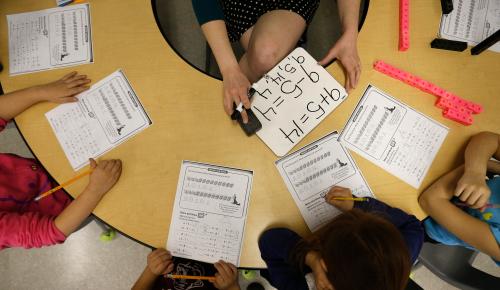Research consistently shows that teacher turnover has negative effects on schools and students. For this reason, education researchers have devoted a great deal of attention to identifying the factors that drive teachers to leave their schools. Several such studies conclude that the quality of a school’s leadership is among the most important predictors of teacher turnover.
Prior studies linking leadership to teacher turnover, however, have not differentiated between high- and low-performing teachers. Differentiating is important because not all teacher turnover is created equal. Principals who implement strategies to retain teachers by giving them teacher-leadership opportunities or recognizing their contributions to the school in other ways presumably focus on strong teachers. For weaker teachers, retention may not be the goal. In fact, an effective principal may be adept at not retaining less effective teachers, either through exercise of administrative means or by “counseling out” teachers to look for a better fit elsewhere.
In a forthcoming study of Tennessee data, Brendan Bartanen and I indeed find evidence that more effective principals are both more likely to retain their best teachers and less likely to retain their lowest-performing teachers, a pattern we refer to as “strategic retention.” To identify more effective principals, we rely primarily on practice ratings given to principals by their supervisors as part of the state’s evaluation system, which we complement with survey-based ratings of leaders from teachers. In schools with higher-rated principals, more effective teachers—measured by both classroom observation ratings and “value added”—are more likely to stay from year-to-year. For example, among the teachers with the highest observation scores (scoring above 4.5 on a five-point scale), the annual turnover rate under a below-average principal is 12.2 percent, compared to 9.6 percent with an above-average principal.
In contrast, we find that teachers who receive the lowest classroom observation scores leave the school at higher rates under an effective principal than an ineffective one. These teachers leave their schools at high rates regardless—the turnover rate among teachers in the bottom 5 percent of observation scores is about 35 percent—but the shift from a below-average principal to an above-average one is associated with an additional 4–5 percentage points in the likelihood that such a teacher moves on.
Importantly, this finding that ineffective teachers leave at higher rates with more effective principals holds only when teachers are measured by observation scores, not student growth. Based on some prior work I did with some other Vanderbilt colleagues, we suspect that this difference occurs because principals collect observation data themselves throughout the year, and they use these observations to learn about teacher performance. In contrast, value-added scores, which are only moderately correlated with observation scores (r = 0.34), are not returned to them until the fall of the next year, meaning that principals cannot take them into account (at least not directly) in making this year’s retention decisions.
We also provide some insight into how strong principals approach removal of less effective teachers. This connection between principal effectiveness and the turnover of teachers with low observation scores holds even among experienced teachers and those whose overall evaluation scores label them as “at expectations.” In other words, the pattern holds even for teachers who are unlikely to be subject to administrative removal or tenure denial, suggesting that counseling out or other informal strategies to encourage teachers to leave are important drivers of the results.
Our analysis also shows that strategic retention patterns are more apparent in schools with stable leadership and in more advantaged schools (i.e., higher-achieving, lower-poverty, suburban). Less advantaged schools may not have a strong pool of teachers waiting to take jobs there, so even effective principals may be less inclined to move out low performers. We also find that ineffective teachers who leave schools with more effective principals overwhelmingly exit the system rather than moving to another school nearby, suggesting that principals are contributing to improvement of overall teacher quality in the district rather than simply engaging in a “dance of the lemons.”
Why do these results matter? First, they highlight an important means through which school leadership can affect schools. Second, they help make an important point about districts’ and states’ huge investments in multiple-measure teacher evaluation systems—arguably the most significant movement in K-12 education policy in the last decade. That point: School principals are the linchpin in determining whether those investments can pay off in terms of reshaping the teacher workforce.
A frequent complaint leveled against new teacher evaluation systems is that, despite all the time and resource costs, teachers are mostly rated highly and no one is ever fired for poor performance. Our results suggest that this conclusion misses some of what is actually going on. The best principals do find ways to release teachers based on what they learn in classroom observations. Less effective principals do this less well. So focusing on building principals’ skills not just to collect high-quality observation data but to make teacher talent management decisions based on what they observe likely is important if states want their evaluation systems to improve the composition of the teacher workforce. Policymakers in most states have given too little attention to principal capacity in the design and implementation of their teacher evaluation systems.
The Brookings Institution is committed to quality, independence, and impact.
We are supported by a diverse array of funders. In line with our values and policies, each Brookings publication represents the sole views of its author(s).








